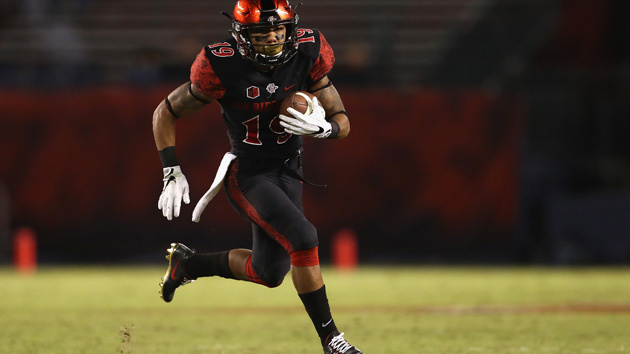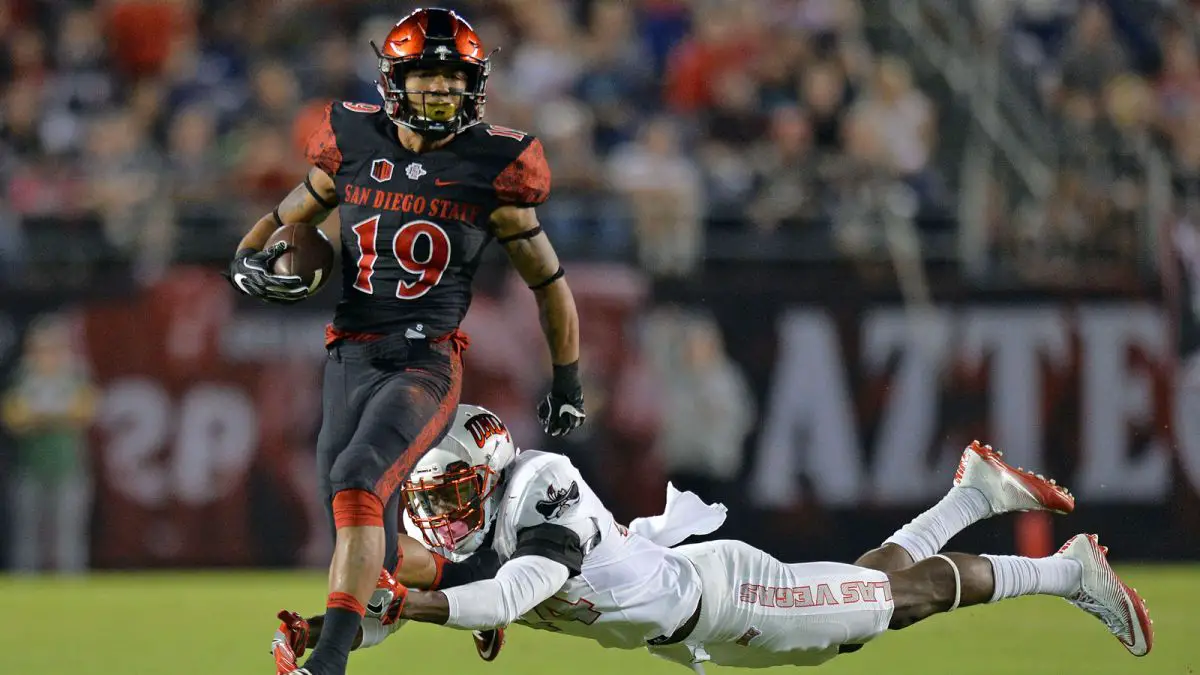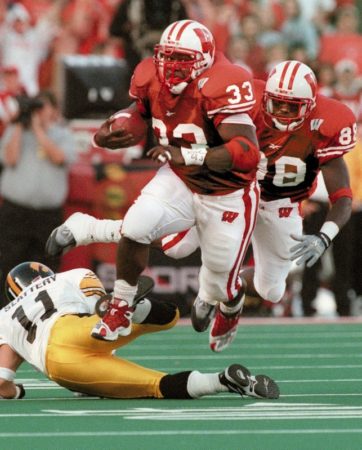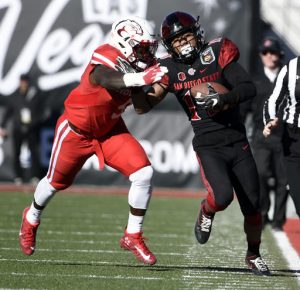The Awkwardness of an All-Time Mark- The Dayne/Pumphrey Situation

SAN DIEGO, CA - OCTOBER 21: Donnel Pumphrey #19 of the San Diego State Aztecs runs upfield for a touchdownduring the first half of a game against the San Jose State Spartans at Qualcomm Stadium on October 21, 2016 in San Diego, California. (Photo by Sean M. Haffey/Getty Images)

Records, they say, are made to be broken.
They signify the highest level of personal achievement in sports. They accompany the proverbial G.O.A.T.’s of our day, “Greatest of All Time”’s like Phelps, Ruth, and Jordan. They let us know, simply and suddenly, that we have witnessed something that has never happened before.
This Saturday, a record was broken. It happened on a toss play to the right, a red-and-black clad young man by the name of Donnel Pumphrey, Jr. slithering towards the edge and then exploding around it for fifteen yards, a first down, and the collegiate level’s career rushing mark. It was a proud moment not just for Pumphrey and his family, nor just for the Aztec football program and San Diego State University, but for the whole of San Diego sports, an often-overlooked community of fans starved for a glimpse of timeless excellence they hadn’t seen since LaDainian Tomlinson was lofted into the air after touchdown number twenty-nine back in 2006.
There was just one problem: a too-big-to-ignore portion of the country will never recognize SDSU’s small-statured speed demon as the career rushing leader. Why?
Allow us to point our fingers once again in the direction of the head-scratching and logic-defying operations of the National Collegiate Athletic Association.
You see, in 2002, the NCAA decided to count bowl statistics toward career totals. Their argument centered around the fact that more and more teams were gaining admittance to postseason play (and trust me, that is another discussion for another day), therefore being rewarded statistically for their team’s success. As a result, players weren’t getting a significant advantage by playing in bowl games every year when compared to an athlete playing for a habitually-poor program.
For all intents and purposes, I see no problem with this determination. If a young man has the game of a lifetime, it should be recognized as such, regardless of when exactly the performance occurs. Vince Young’s legendary 467-yard, 3-touchdown performance in the 2006 Rose Bowl is just one example of shake-your-head-in-disbelief superiority that deserves to find its way into the record books if it qualifies to do so.

The problem came with how the NCAA followed up their statement: bowl statistics accumulated prior to 2002 would not count towards career marks. Suddenly, modern-day ballplayers had been granted a noteworthy upper hand when it came to setting and breaking NCAA records.
As a result, Pumphrey’s 328-yard rushing total in bowl games (plus another 200 if you want to include conference title games as well) counts towards his ledger, but the 728 yards that could be attributed to previous leader Ron Dayne’s career total do not.
That just doesn’t make sense.
The NCAA’s logic was that the decision represented a solution to the struggles of trying to obtain and verify statistics from the yesteryear of college football. Fair enough – no one has access to complete statistics from the Depression-era heyday of Notre Dame’s Four Horseman, for example. That fact does not hold true for the vast majority of college football’s history, however. Consequently, the NCAA’s incomplete accounting does not accurately reflect the all-time accomplishments of its athletes.
As a result, Donnel Pumphrey is the college game’s career rushing leader despite Ron Dayne (and, for that matter, Tony Dorsett) piling up more yards than him during their collegiate careers. In fact, if bowl statistics are counted for all players, the rushing leaderboards (courtesy of Sports Reference), while similar to the NCAA’s version, look different enough to warrant discussion:
- Ron Dayne – 7,125 yards
- Tony Dorsett – 6,526 yards
- Donnel Pumphrey – 6,405 yards
- Ricky Williams – 6,279 yards
- Charles White – 6,245 yards
- DeAngelo Williams – 6,026 yards
- Travis Prentice – 5,596 yards
- Archie Griffin – 5,589 yards
- Cedric Benson – 5,540 yards
- LaDainian Tomlinson – 5,387 yards
Even if one takes a different approach, and decides to exclude all postseason tallies from players’ personal ledgers, Dayne’s 6,397-yard total still outpaces San Diego’s new gridiron great by more than five hundred yards.

Forget the media attention, both national and local, that was paid to Pumphrey’s big day. Forget the heartwarming postgame moment between Pumphrey and his father, two men sharing in the glorious emotion of the afternoon. Forget the tens of thousands of us who cheered Pumphrey and the Aztecs along all year.
It doesn’t count. #19 is #1 in the eyes of the NCAA and the majority of San Diegans, but not in the collective eyes of the nation.
This is to take nothing away from the accomplishments of the gracious and talented young man from Las Vegas. His was a season and a career like few we have ever seen before, and should be recognized as such regardless of where he sits in the record books. To adore him as the nation’s most prolific runner, however, is both uncomfortable and unfair.
Ultimately, the fault lies not with the man who entered the record books today, but with the bookkeeper himself. Records should not be accompanied by asterisks or disagreement or detracting side notes. They are, and should remain, the undisputed truths of sporting greatness. Unfortunately for Montezuma Mesa and Aztec alumni around the globe, the NCAA has rendered those marks sub-standard proofs of athletic excellence.
There is little doubt that Donnel Pumphrey will be remembered as a great college football player.
But the Greatest of All Time? As much as it hurts to say, the Aztecs’ latest legend still comes up short.
Noah is a current undergraduate at the University of San Diego. In addition to his classes as a Business Economics student, Noah serves as the scouting director for the nationally-ranked USD baseball team and as an NFL correspondent with The Mighty 1090. You can follow him on Twitter @thebackseatlamp